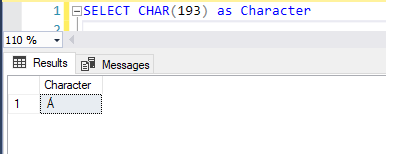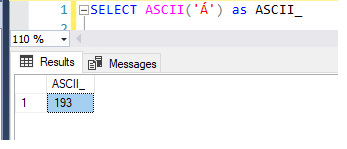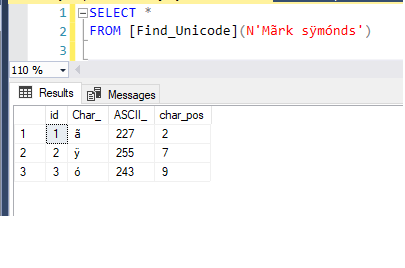Function to Read a File Where Fields Were Separated With â€å“|ã¢â‚¬â
In this article, I'll provide some useful information to help you understand how to utilise Unicode in SQL Server and address various compilation problems that ascend from the Unicode characters' text with the help of T-SQL.
What is Unicode?
The American Standard Code for Information Interchange (ASCII) was the first extensive character encoding format. Originally adult in the U.s.a., and intended for English, ASCII could only accommodate encoding for 128 characters. Grapheme encoding simply means assigning a unique number to every character being used. As an example, we show the letters 'A','a','ane′ and the symbol '+' become numbers, every bit shown in the table:
| ASCII('A') | ASCII('a') | ASCII('1') | ASCII('+') |
| 65 | 97 | 49 | 43 |
The T-SQL statement below can help us notice the character from the ASCII value and vice-versa:
| SELECT CHAR ( 193 ) as Graphic symbol |
Here is the result gear up of ASCII value to char:

| SELECT ASCII ( 'Á' ) as ASCII_ |
Here is the result set of char to ASCII value:

While ASCII encoding was acceptable for almost common English language characters, numbers and punctuation, it was constraining for the rest of the world's dialects. As a result, other languages required different encoding schemes and character definitions changed co-ordinate to the linguistic communication. Having encoding schemes of different lengths required programs to figure out which 1 to apply depending on the language being used.
Here is where international standards become critical. When the entire world practices the same character encoding scheme, every computer can display the aforementioned characters. This is where the Unicode Standard comes in.
Encoding is always related to a charset, so the encoding process encodes characters to bytes and decodes bytes to characters. There are several Unicode formats: UTF-8, UTF-16 and UTF-32.
- UTF-8 uses 1 byte to encode an English character. It uses between 1 and 4 bytes per character and it has no concept of byte-order. All European languages are encoded in ii bytes or less per character
- UTF-xvi uses two bytes to encode an English character and it is widely used with either 2 or 4 bytes per character
- UTF-32 uses 4 bytes to encode an English character. It is all-time for random admission by character offset into a byte-assortment
Special characters are often problematic. When working with unlike source frameworks, information technology would be preferable if every framework agreed as to which characters were acceptable. A lot of times, it happens that developers perform missteps to identify or troubleshoot the result, and however, those issues are identified with the odd characters in the data, which caused the mistake.
Unicode information types in SQL Server
Microsoft SQL Server supports the below Unicode information types:
- nchar
- nvarchar
- ntext
The Unicode terms are expressed with a prefix "North", originating from the SQL-92 standard. The utilization of nchar, nvarchar and ntext data types are equivalent to char, varchar and text. The Unicode supports a broad scope of characters and more space is expected to store Unicode characters. The most extreme size of nchar and nvarchar columns is 4,000 characters, not 8,000 characters like char and varchar. For example:
Northward'Mãrk sÿmónds'
All Unicode data practices the identical Unicode code page. Collations do not regulate the code page, which is beingness used for Unicode columns. Collations command only attributes such equally comparison rules and case sensitivity.
This T-SQL statement prints the ASCII values and characters for the ASCII 193-200 range:
| SELECT CHAR ( 193 ) , CHAR ( 194 ) , CHAR ( 195 ) , CHAR ( 196 ) , CHAR ( 197 ) , CHAR ( 198 ) , CHAR ( 199 ) , CHAR ( 200 ) |
| CHAR(193) | CHAR(194) | CHAR(195) | CHAR(196) | CHAR(197) | CHAR(198) | CHAR(199) | CHAR(200) |
| Á | Â | Ã | Ä | Å | Æ | Ç | È |
Get a list of special characters in SQL Server
Here are some of the Unicode character sets that can be represented in a single-byte coding scheme; nonetheless, the character sets require multi-byte encoding. For more than information on character sets, check out the beneath function that returns the ASCII value and character with positions for each special character in the string with the help of T-SQL statements:
Function:
| one two 3 4 5 6 7 8 nine 10 11 12 xiii 14 fifteen xvi 17 xviii xix 20 21 22 23 24 | CREATE FUNCTION [ dbo ] . [ Find_Unicode ] ( @ in_string nvarchar ( max ) ) RETURNS @ unicode_char TABLE ( id INT IDENTITY ( 1 , 1 ) , Char_ NVARCHAR ( 4 ) , position BIGINT ) As Brainstorm DECLARE @ character nvarchar ( 1 ) DECLARE @ alphabetize int Set up @ index = 1 WHILE @ index <= LEN ( @ in_string ) Brainstorm SET @ character = SUBSTRING ( @ in_string , @ index , 1 ) IF ( ( UNICODE ( @ character ) Non BETWEEN 32 AND 127 ) AND UNICODE ( @ character ) NOT IN ( x , 11 ) ) Brainstorm INSERT INTO @ unicode_char ( Char_ , position ) VALUES ( @ graphic symbol , @ index ) END Prepare @ alphabetize = @ alphabetize + i Terminate RETURN Finish GO |
Execution:
| SELECT * FROM [ Find_Unicode ] ( N 'Mãrk sÿmónds' ) |
Here is the issue fix:

Remove special characters from string in SQL Server
In the lawmaking below, we are defining logic to remove special characters from a string. We know that the bones ASCII values are 32 – 127. This includes capital messages in social club from 65 to 90 and lower example letters in order from 97 to 122. Each character corresponds to its ASCII value using T-SQL. The "RemoveNonASCII" function excludes all the special characters from the cord and sets up a blank of them:
| ane two iii 4 5 6 vii viii 9 10 11 12 13 xiv 15 16 17 18 19 20 21 22 23 24 25 26 | CREATE FUNCTION [ dbo ] . [ RemoveNonASCII ] ( @ in_string nvarchar ( max ) ) RETURNS nvarchar ( MAX ) AS BEGIN DECLARE @ Issue nvarchar ( MAX ) SET @ Result = '' DECLARE @ character nvarchar ( 1 ) DECLARE @ index int Set up @ index = 1 WHILE @ alphabetize <= LEN ( @ in_string ) BEGIN SET @ character = SUBSTRING ( @ in_string , @ index , 1 ) IF ( UNICODE ( @ graphic symbol ) betwixt 32 and 127 ) or UNICODE ( @ character ) in ( x , 11 ) Prepare @ Outcome = @ Result + @ graphic symbol SET @ index = @ index + ane END Return @ Issue Stop |
Execution:
| SELECT dbo . [ RemoveNonASCII ] ( Northward 'Mãrk sÿmónds' ) |

These SQL functions can be very useful if y'all're working with large international grapheme sets.
- Author
- Recent Posts
![]()
Source: https://www.sqlshack.com/manage-unicode-characters-in-data-using-t-sql/
0 Response to "Function to Read a File Where Fields Were Separated With â€å“|ã¢â‚¬â"
Post a Comment